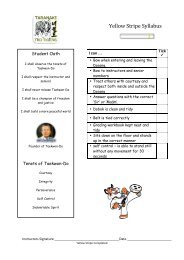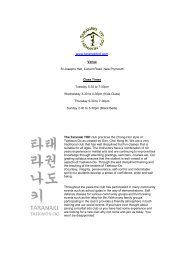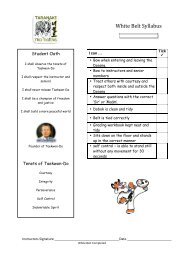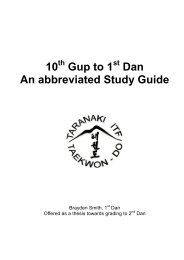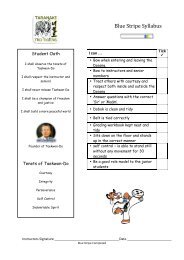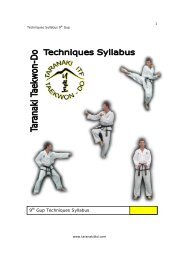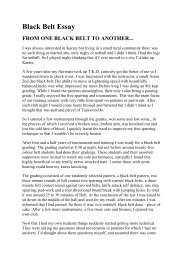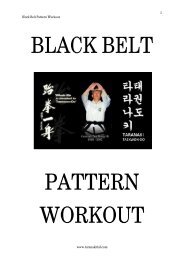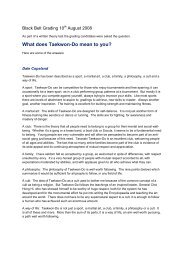Taekwon-Do Patterns (Tul) - Taranaki ITF Taekwondo
Taekwon-Do Patterns (Tul) - Taranaki ITF Taekwondo
Taekwon-Do Patterns (Tul) - Taranaki ITF Taekwondo
You also want an ePaper? Increase the reach of your titles
YUMPU automatically turns print PDFs into web optimized ePapers that Google loves.
<strong>Taekwon</strong>‐<strong>Do</strong> <strong>Patterns</strong><br />
In 1906, following the Russo‐Japanese war, Ahn learned of the Japanese<br />
"Protectorate Treaty" that had been enforced on Korea, which gave the<br />
Japanese the legal right to occupy the country, and returned home. He<br />
organised an underground independence group in Pyongahn‐do called<br />
Shinmin‐Hoe (New Peoples' Association), an organisation dedicated to<br />
promoting Korean independence through the cultivation of nationalism in<br />
education, business and culture.<br />
In 1908 the Shinmin‐Hoe founded the Tae‐Song ("large achievement") School<br />
in Pyongyang. This school was designed to provide Koreans with an<br />
education based on national spirit. Ahn, Chang‐Ho worked a ceramic kiln as a<br />
commercial enterprise to raise funds for the publication of books for young<br />
people. The political environment of the time, however, was not conducive<br />
to the founding of such a school; in fact the Japanese were in the process of<br />
eradicating education for Koreans, in order to ensure illiteracy and<br />
essentially create a class of slave workers.<br />
With Yi Kap, Yang Ki‐tak and Shin Chae‐Ho, Ahn embarked on a lecture tour<br />
of Korea, warning of the national crisis being incurred by the Japanese and<br />
urging the people to unite and resist the Japanese. Ahn repeatedly told<br />
Japanese leaders that Japan would profit more with Korea as a friend rather<br />
than an enemy.<br />
By 1910 the Shinmin‐Hoe had around 300 members and represented a<br />
threat to the Japanese occupation. The Japanese were actively crushing<br />
these types of organizations, and the Shinmin‐Hoe quickly became a target<br />
of their efforts. In December of 1910 the Japanese Governor General,<br />
Terauchi, was scheduled to attend the dedicating ceremony for the new<br />
railway bridge over the Amnok River. The Japanese used this situation to<br />
pretend to uncover a plot to assassinate Terauchi on the way to this<br />
ceremony. All of the Shinmin‐Hoe leaders and 600 innocent Christians were<br />
arrested. Under severe torture, which led to the deaths of many, 105<br />
Koreans were indicted and brought to trial. During the trial, the defendants<br />
were adamant about their innocence. The world community felt that the<br />
alleged plot was such an obvious fabrication that political pressure grew and<br />
most of the defendants had to be set free. (By 1913, only six of the original<br />
defendants had received prison sentences.)<br />
By this time, the Japanese had become fairly successful at detecting and<br />
117






